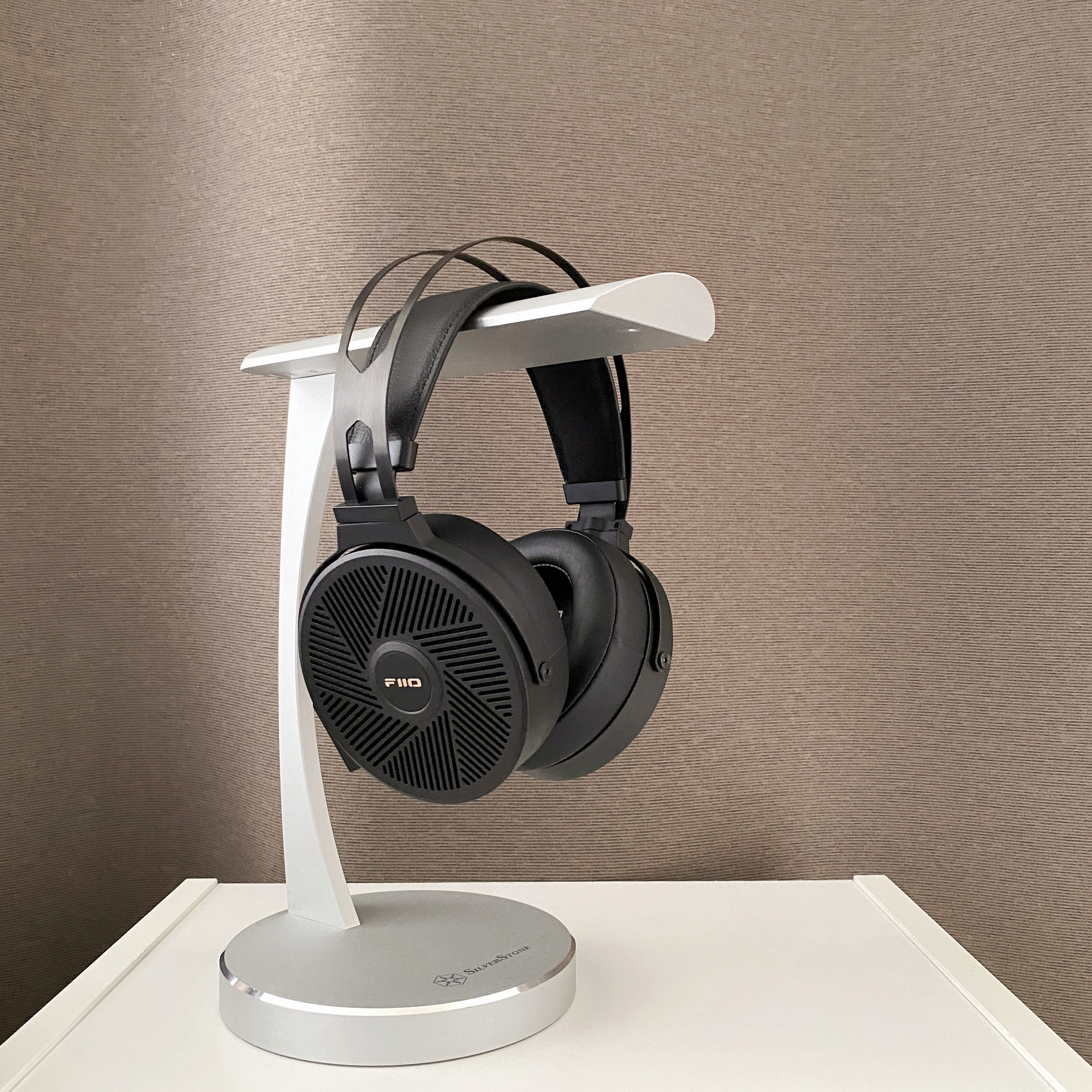
An anti-hifi hifi headphone?
Intro
Fiio is a established brand for portable earphones and playback devices. The introduction of the FT3 and FT5, an ambitious duo of a dynamic driver and a planar, marks the brand’s venture into the headphone arena.
Today we have here the FT5. One can clearly see effort and thought put into the machined aluminium body and the comfort of the ear pads and head strap. But the big question remains: how does it hold up against the competition? Are we looking at a real contender to the likes of Hifiman and Audeze, or does it offer something else? Let’s find out.
(for the full suite of measurements, see the final section of the article)
Specs & Comfort
Price: US$ 450, AU$ 850
Transducer size: 90 mm (advertised)
Effective area: 75 mm approx.
Transducer type: planar magnetic
Earpad size: 100*100*27-20mm
Earpad fitting mechanism: clip-on
Sensitivity: 97 dB/mw @1kHz
Impedance: flat, 40Ω @1kHz (measured)
Connector: dual 3.5mm TRS
Weight: 467 grams
Clamping force: light-medium
Headband swivel: YES (40° approx.)
Comfort: 7/10 (slightly weighty; headstrap a bit tight; quite good otherwise)
Mesurement & Sound
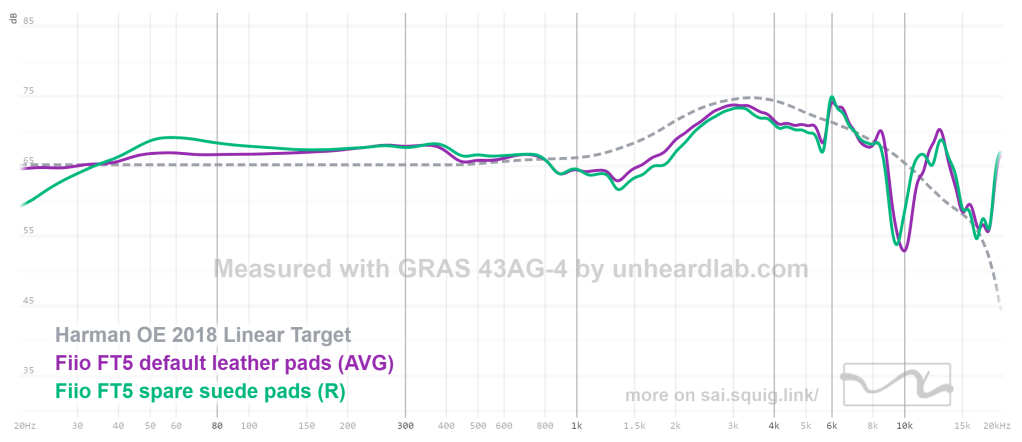
link to the frequency response measurement & more comparisons
Tonal balance:
Overall, FT5 presents a warm sound profile that is quite rare among open-back planars. The bass and mids dominate the stage, but it isn’t a particularly dark headphone. Technical performance is, however, average at best. Switching to suede ear pads clears things up a bit, but at the cost of bass impact. The following sections of the review is done mainly using the leather pads.
The bass is notably warm, edging towards being bloated and muddy. It’s particularly elevated in the upper bass, leading to a woolly and boomy presentation. While the bass fills the space, it doesn’t quite rock it. For those who prefer genres that demand bass clarity or robust punch, the FT5 may not be a good choice. But for softer genres like jazz and country, I can see the appeal.
The midrange is warm and full-bodied, but lacks articulation. While it has a reasonable presence in the upper mids harmonics, this often gets overshadowed by the upper-bass dominance and the warmth of the lower mids fundamentals. It is not recessed as some of the Audezes, though. It’s a bit reminiscent of Hifiman headphones in terms of vocal distance, but the FT5 adds a warmer and woolly twist. It’s got that vibe of the HD6XX/650, though not as forward.
Getting into the upper-mids and treble transition, the FT5 keeps things smooth. The potential for graininess/harshness is reduced, resulting in somewhat lush performance. Again, it’s unmistkably coloured, but in a slightly subtler way than headphones like the Audeze LCD-3.
The treble is generally inoffensive and well-controlled below 8kHz, a range where our hearing is more sensitive. Instruments like the violin or the ride cymbal are given enough energy to sound clear, while not becoming aggressive. Occasional sibilance in female vocals might be noted, but this issue is confined to a relatively narrow frequency band and not a serious issue for most tracks.
The upper treble, like many planars, can be slightly hot around the 12-13kHz zing and sizzle region. While so, I find it could benefit from extra air to counterbalance the bass warmth. To be sure, t’s not a dark or dull headphone. But a slight lift in the sense of air would defintely take it to another level.
Other qualities:
- Soundstage and Imaging:
The soundstage of the FT5 doesn’t quite hit the mark. The lateral stage feels limited, which means that even when sounds are meant to convey a sense of distance – as intended by the artist – they tend to come off more intimate than expected. This is particularly true when the lower-mids and bass are more pronounced, sometimes even adding a ‘reverby’ quality to the mix, which, admittedly, might appeal to some listeners.
Depth projection doesn’t fare much better, leaving a bit to be desired. Therefore, for genres that rely heavily on spatial cues, like orchestral compositions, the FT5 might not be the best fit. In contrast, headphones like the Hifiman Sundara offer a more expansive and well-defined soundstage.
Imaging on the FT5 is adequate but not impressive. While the center image comes across clear and well-defined, the imaging towards the sides can appear somewhat blurred. It doesn’t suffer from the ‘three-blob’ effect but still lacks precision. The overall sense of distinction and layering doesn’t stand out, especially when compared to the more competent soundstage and imaging capabilities of the Moondrop Para.
- Clarity:
The sense of clarity manages to meet the threshold of being acceptable. When placed in comparison with other planar headphones in its price range, the FT5 finds it challenging to match their level of clarity and resolution. The Moondrop Para stands out as a notable case, delivering superior clarity at a significantly lower price.
Indeed, the tuning of the FT5 seems deliberately sacrificing some of the clarity, opting to trade off some detail retrieval for warmth. Against those with a similar tuning, such as the HarmonicDyne Zeus, the FT5 does manage to provide a higher level of clarity. However, the difference is not stark. When compared to the DCA Aeon Open X, the FT5 slightly lags in terms of clarity but compensates with a smoother and more balanced presentation.
- Dynamics and Impact:
The dynamics of the FT5 is lackluster. The contrast between loud and soft passages tends to be gentle and a bit on the mushy side, making complex passages somewhat compressed sounding. Finer details, like the transients in the opening and closing of hi-hats, might not be as discernible as one would hope. Compared to the Hifiman HE6se, which sports a less V-shaped sound profile, the FT5 falls short in delivering a robust sense of contrast.
When it comes to impact, the FT5 doesn’t particularly stand out in this aspect. Despite its ample bass quantity, the slam isn’t as pronounced or hard-hitting as one might expect from the visual representation of its bass response. It operates on a similar level to the Aeon Open X in terms of impact, offering a presence that’s noticeable but not overwhelmingly powerful.
Conclusion and value:
So, who’s the Fiio FT5 for, and where does it sit in the competition? While the tuing hasn’t won me over, it’s clear that Fiio targets the smaller market segment looking for a distinctively warm sound. In this sense, the FT5 feels like an ‘anti-hifi’ headphone, not designed to impress with its technical marvel but rather to offer a pleasing listen. It draws parallels with the Meze planars, namely the Empyrean and the Elite, offering a relatively affordable gateway to a warm planar sound.
The real competition here is the DCA Aeon series, with the Aeon Open X being a particularly close match in terms of price and tuning. The FT5 edges out with a smoother and more balanced sound, making it suitable for a wider range of genres. Another advantage of the FT5 is the use of 3.5mm connectors over the DCA’s proprietary DUMMER type. The option for interchangeable cable terminations further sweetens the deal.
In conclusion, priced at US$ 450/AU$ 850, the Fiio FT5 isn’t an impressive offering, especially for those looking for the neutral sound or a technically capable planar. However, if this particular tuning speaks to you, the FT5 can be a plausible option, considering its good ergonomics and build quality.
Pros: warm, smooth and inoffensive sound that could make certain genres enjoyable; never grainy or gritty sounding; decent build and ergonomics; generous accessories;
Cons: bass lacks impact and slam; somewhat mushy and compressed sounding; intimate staging; the level of clarity is unimpressive;
Value Grade (assessment on value, NOT sound quality):
Notes on EQ
The Fiio FT5 could benefit significantly from EQ. Once you adjust the level of the upper-bass, the tonal improvement is obvious. It’s a relatively easy headphone to EQ. I added a smidge of 3khz energy around the ear gain peak for a clearer sound.
My EQ setting for this headphone (with the leather pads):
Preamp: -6.0 dB
Filter 1: ON PK Fc 23 Hz Gain 6.0 dB Q 0.500
Filter 2: ON PK Fc 250 Hz Gain -4.0 dB Q 1.000
Filter 3: ON PK Fc 1500 Hz Gain 4.0 dB Q 1.500
Filter 4: ON PK Fc 3200 Hz Gain 1.0 dB Q 2.000
Filter 5: ON PK Fc 4400 Hz Gain 3.0 dB Q 2.000
Filter 6: ON PK Fc 6400 Hz Gain -3.0 dB Q 3.000
Filter 7: ON PK Fc 12800 Hz Gain -3.0 dB Q 3.000
If you would like to EQ to the Harman Target, there’s an handy AutoEQ function built in Squiglink that you could use as a starting point (I personally do not recommend doing so – ideally you should adjust the filters to suit your own hearing especially in the treble).

MEASUREMENTS
Frequency Response Average (unsmoothed):

Bass extension cutoff is 10hz so as to fully capture frequencies which though outside of the ‘audible range’, may be felt by our bones and muscles. The response is obtained by an average of 5-6 positional variations. The graph is unsmoothed.
Positional Variation:

This graph shows how the tonality might be affected when you wear the headphones differently on the head.
Leakage Test:
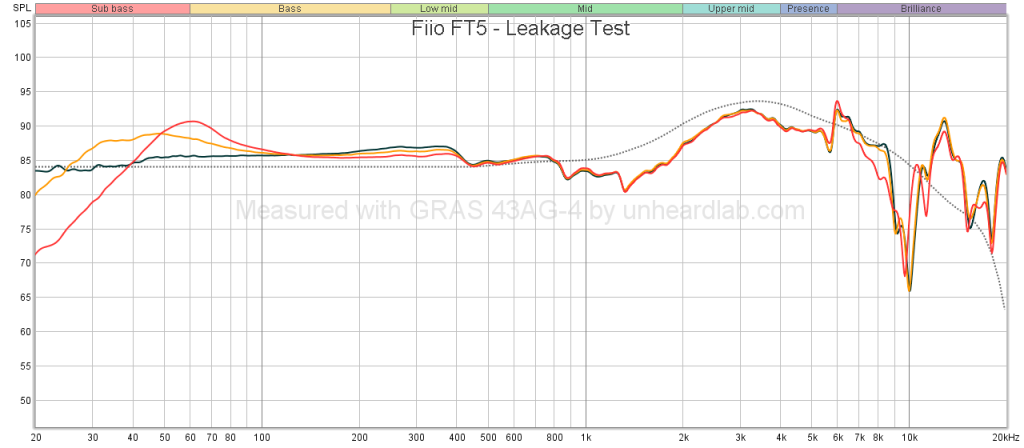
This graph demonstrates how a small leakage (simulated using thin-armed glasses) can result in FR change.
Impulse Response:

Impulse response contains information about transducer movement when a test tone is played.
Channel Matching:
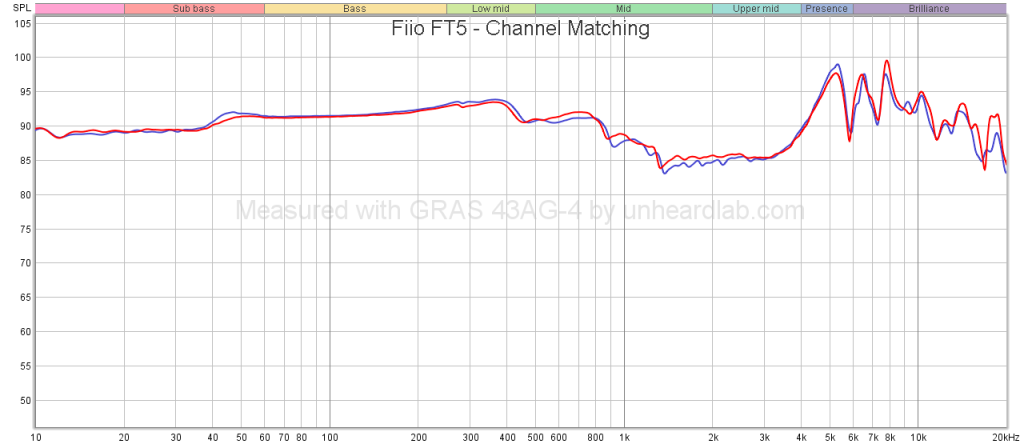
Channel matching graphs do not relate to the sound profile. A specialised configuration is used to capture differences between channels, mitigating interference from positioning on the rig and the asymmetry in the GRAS pinnae design, a legacy of KEMAR. The left (blue) and right (red) channels are measured using a flat plate coupler with an IEC60318-4 ear simulator.
Electric Phase & Impedance:
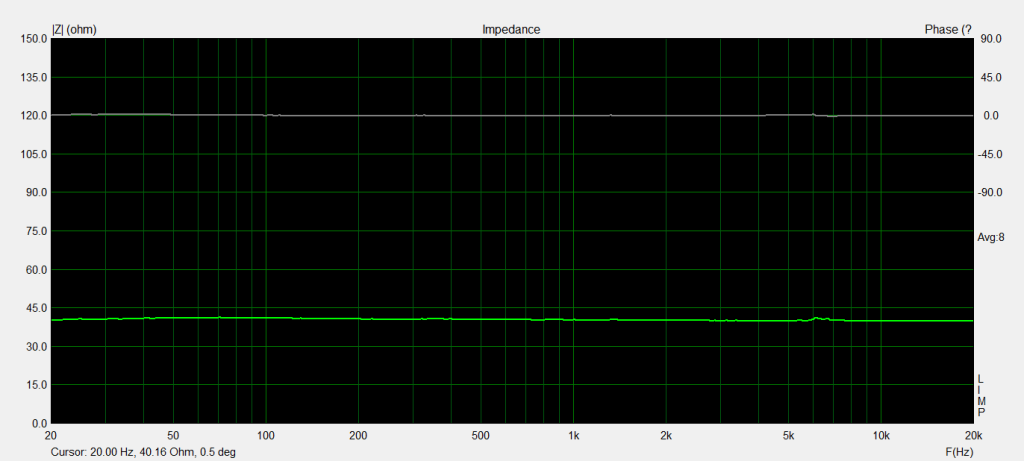
The above graph shows the measured impedance (green) and electric phase (grey).
END OF THE ARTICLE
Disclaimer: This review is not sponsored or endorsed by any business or related entity. The headphones reviewed are my own unless stated otherwise. Any links or recommendations included are purely informational and do not involve any financial affiliation or endorsement on my part.

How does this compare to the LCD-2C?
LikeLike
I’d take the LCD-2C unless its weight is a major concern. Both have a somewhat unorthodox tuning that would benefit from a bit of EQ, but in terms of the subjective qualities like soundstage and detail retrieval, the 2C has the edge. Although, the 2C is also quite a bit more expensive.
LikeLike
Which has more bass between the two? Is the price difference worth it?
I have a DT700 Pro X + Fiio K7 BT and mostly listen to EDM and Hiphop/R&B.
Looking for my first planars.
LikeLike
Between the two, the FT5 has more upper-bass warmth, while the LCD-2C has more sub-bass oomph due to its more linear bass response.
Both are fairly easy to drive, so you shouldn’t have any issues with amping.
For the genres you mentioned, I’d lean towards the LCD-2C. It has more slam and impact, plus a wider soundstage. Whether the extra $350 (almost double the FT5’s price) is worth it is a valid question. The sound differences are noticeable but might not justify the price gap for everyone. Looking for a good condition used pair of the 2C could be the way to go. 😉
LikeLike
Thanks!
LikeLike
I bought this headphone after reading so much good about it. But this review is exactly like my thoughts on it.
LikeLiked by 1 person
Thank you – that really motivates me to keep writing. I always aim to be honest and detailed in my reviews, so it’s very reassuring to hear that my thoughts align with yours. If there’s anything else you’d like to discuss or share, I’m all ears!
LikeLike